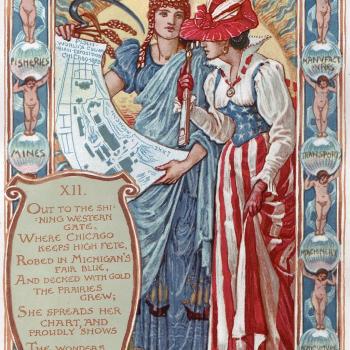The idea for this post came from my genuine surprise at reading a passage by Winston Churchill. It made me reflect on some aspects of what we might describe as the “forgotten history” of Islam and its relations with the West, a point I raised in a recent post.
In 1899, Churchill expressed grave concern about the “militant and proselytizing faith” of Islam. To put this in context, he actually wrote,
Individual Muslims may show splendid qualities, but the influence of the religion paralyses the social development of those who follow it. No stronger retrograde force exists in the world. Far from being moribund, Mohammedanism is a militant and proselytizing faith. It has already spread throughout Central Africa, raising fearless warriors at every step; and were it not that Christianity is sheltered in the strong arms of science, the science against which it had vainly struggled, the civilization of modern Europe might fall, as fell the civilization of ancient Rome.
His contemporary, Lord Cromer, administered Egypt as an energetic modernizer: how else, he worried, could he prevent the deadly danger of the “political regeneration of Mohammedism”?
In one way, it’s not difficult to understand why British observers at that specific moment thought Islam that posed a political danger. Only in 1898 had British forces destroyed the messianic revivalist movement led by the Mahdi in the Sudan. But even so, from a modern perspective, such fears surely seem overblown. As I stressed in a recent column, Islam in this era was close to the nadir of its fortunes globally, t the point that its survival seemed in doubt. In retrospect, we know, or think we know, that the political revival of Islam would be a much later phenomenon, dating perhaps from the post-1973 boom in Saudi oil wealth and Wahhabi proselytizing, and from the 1979 revolutions in Iran and Afghanistan. That new wave crested with the Islamic State after 2014, and it would be wonderful to think that its failure marked a decisive turning point in the story. Only by a real stretch (it seems) could modern Islamic militancy be traced back much further, perhaps to the foundation of the Muslim Brotherhood in 1928. What on earth was Churchill talking about?
In reality, Islamic revolutionary and military movements had flourished around the world for at least a century before the 1920s, and the theaters of combat were very much the same then as now, with prolonged and often successful jihadi struggles in the Sudan and the Horn of Africa, in Algeria and Morocco, India and Afghanistan, the East Indies and the Caucasus, China and Central Asia. The story is striking enough in its global sweep, but it also tells us much about how we in the contemporary West write and understand history, and how systematically we have failed to take account of religious dimensions. Whether or not the theory of a clash of civilizations should shape attitudes in the modern world, conflicts between Muslim societies and European Christian nations undeniably have been a fairly continuous reality in modern history. So important were these movements – and so easy to find in the historical record – it seems amazing that modern day Westerners have been so startled by the potency of religious-based revolutionary militancy. Even more puzzling is their belief that this represents something new.
From the late eighteenth century onwards, much of European military history and lore was formed in conflict with Muslim populations – by the British in India, the French in North Africa, the Russians in the Caucasus, the Dutch in the East Indies, the Spanish in Morocco, the Italians in Libya. From the 1830s onwards, expanding European empires everywhere encountered militant nationalist movements, which were commonly motivated by Islam and the rhetoric of jihad. What the British remember as the Indian Mutiny of 1857 was to thousands of its participants a jihad against the British infidel. In the 1860s, Muslim rebels in southwest China sustained an independent sultanate in rebellion against the Chinese imperial regime, and other Muslim revolts flared elsewhere in China’s weakly controlled far West. In 1873, the East Indian sultanate of Aceh began a thirty-year revolution that the Dutch never wholly suppressed. At the height of its success, the Muslim secessionist regime in Aceh was quite as independent of imperial control as was the Mahdist state in Sudan. Even as far afield as Brazil, black Muslim slaves kept alive a sturdy militancy, which occasionally flared into open urban revolt.
Perhaps the greatest of the Muslim opponents of empire was Imam Shamil, who fought doggedly against Russian expansion in the Caucasus from 1834 to 1859. He became the legendary exemplar for Muslims in the Caucasian state, and is also commemorated in Tolstoy’s novel Hadji Murad. Imam Shamil’s contemporary Abd al-Qadir occupies the same heroic position in the mythology of modern Algeria. In the 1920s, Omar al-Mokhtar led mujahedin resistance against the Italian occupation of Libya, becoming a hero for Libyans and others. When Palestinian Hamas supporters parade in contemporary Gaza, they commonly march down Omar al-Mokhtar Street. Somalis venerate Mahammad Abdille Hasan, who kept British forces at bay from 1899 until his death in 1920. The fact that the British dismissed him as the “Mad Mullah” speaks volumes for their utter failure to grasp his motivation. Moroccans fondly recall Abd al-Krim, whose forces slaughtered thousands of Spaniards in the 1920s, and whose guerrilla tactics inspired Ho Chi Minh.
In many ways, these various movements resemble the forces of contemporary Islamist radicalism, not least in the centrality of the concept of jihad. Nineteenth century Iranian regimes proclaimed the holy quality of their struggles against infidel Russians and British. Then as now, revolutionary movements received the support of Muslim scholars and clergy, and Sufi orders were critical to the organization of radical activities. Modern jihadis differ from their predecessors chiefly in their access to modern means of travel and mass communication, which permit the formation of international alliances and coalitions. Nor, of course, could those nineteenth century rebels count on sympathetic Muslim populations within the imperial states themselves.
Often, we can see direct continuities from the radical movements of that earlier period. Modern South Asian Islamist movements such as the Taliban and the Tablighi Jama’at trace their origins to the Deobandi school founded in the aftermath of India’s failed 1857 jihad. Chechen movements similarly trace their inheritance to nineteenth century predecessors, and modern-day guerrilla leader Shamil Basayev was named for the legendary Imam.
Why do modern accounts of Islamic politics so rarely take account of this critical lost history? In large measure, both Western and Third World historians long shared a common blindness to the religious character of the movements, which were at best seen as the romantic stumblings of pre-modern “primitive rebels”. Secular-minded historians rarely granted that any truly modern movement could seriously claim a religious basis. Yet from the standpoint of the early 21st century, these insurgencies must carry a renewed relevance. And they are essential for any attempt to understand what we misleadingly call the modern “revival” of radical Islamist activism.
A version of this appeared in Chronicles magazine as “The Revolt of Islam.”












